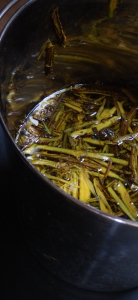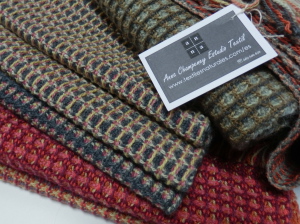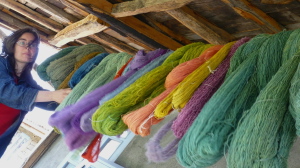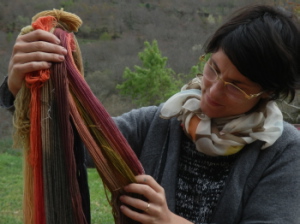¿Te interesa realizar un curso online de tècnicas del tejido en telar con Anna Champeney?Si te interesa aprender técnicas de diseño y tejido en telar de bajo lizo online, escríbanos y suscribir a nuestro boletín.
 Contacta con nosotros |  Today I analysed this cushion design by the Welsh weaving mill Melin Trygwynt. It´s a particularly pleasing, geometric design and the mill produce the design as cushions, blankets and other products in wool. Today I analysed this cushion design by the Welsh weaving mill Melin Trygwynt. It´s a particularly pleasing, geometric design and the mill produce the design as cushions, blankets and other products in wool.
Below you can see the fabric window view of my weave software which I used to “discover” the “formula” behind the pattern.  It has been an interesting exercise to analyse the design and see how it was woven. You learn a lot from this process. In theory I could weave a design which uses the same colours and type of yarn and the result would be similar to the Melin Trygwynt piece, but it would be questionable to do this from an ethical viewpoint. When there is so much scope for creating original design why imitate or copy someone elses? It´s often because of a lack of knowledge and skill. It has been an interesting exercise to analyse the design and see how it was woven. You learn a lot from this process. In theory I could weave a design which uses the same colours and type of yarn and the result would be similar to the Melin Trygwynt piece, but it would be questionable to do this from an ethical viewpoint. When there is so much scope for creating original design why imitate or copy someone elses? It´s often because of a lack of knowledge and skill.
From a personal viewpoint, the idea of copying designs just doesn´t interest me and never has. For this reason I find the idea of using pattern books as ready-made design sources quite boring. I am also reluctant to tell my students exactly how pieces are woven – because I´m far more interested in showing them the principles behind the design so they can go on to create original designs themselves. It takes a long time and experience to start to master this though, probably a lifetime. I am more interested in learning about how patterns work and how woven structure and colour can work together in original and interesting ways in order to develop my own style. Sampling using standard patterns is a useful first step, although even then I always introduce elements of my own and use that as a springboard. But increasingly the idea for the design comes first and then I look for ways to translate it into a woven textile. Ths leads me on to suggesting that small-scale, high-end independent fashion designers in Spain can also approach the issue of fabric in a different and more interesting way. I am sometimes approached by young designers wishing me to weave fabric by hand. I have yet to meet a designer who is actually aware of the work involved and the time a craftsperson needs to work on an entirely new weave project and most projects founder because the designer hasn´t realised just how time-consuming it is to create a bespoke textile. Designers often lament how little craftspeople know about design, and often they have a point. But designers are also pretty ignorant about how craftspeople work and see them simply as suppliers of labour and have a lot to learn as well. A textile designer contacted me only last week to ask me if I could wave a short length of fabric for a prototype range of clothing using a very classic, simple pattern. The idea was interesting in principle and I suggested that the classic design could be updated and given a contemporary twist rather than weaving the existing, standard design. Because I understand how structure and pattern works I know how to adapt a classic style and give it an original touch or flavour, adding value and interest to the final garment design. I´m not really that interested, as a hand-weaver, in replicating standard, classic designs; hand-weaving is an incredibly time-consuming process so if you´re going to commission some expensive hand-made, limited-edition fabric then the quality and appropiateness of the design is fundamental. But if weavers in Spain don´t develop these these design skills or knowledge of how to adapt classic designs they are limited to copying standard designs and this can only lead to dull, stagant design. This is quite common. In fact classic designs have always been re-worked in fashion because they are so successful, but they do need to be adapted as tastes evolve. My own view is that to keep a competitive edge requires innovation rather than replication. And this depends on skill and creativity and the ability to develop one´s own style. And although it takes time, it´s a lot more satisfying than copying or weaving traditional patterns.    These charming mini-catalan baskets are ideal presents for your young kids or grandchildren – so they can harvest fruit and veg from the garden or even help mum and dad with the shopping! These charming mini-catalan baskets are ideal presents for your young kids or grandchildren – so they can harvest fruit and veg from the garden or even help mum and dad with the shopping!
Mini baskets include versions similar to the traditional Catalan mushrooming basket, the double “potato peeling” (pelapatas) basket. But Lluis will also be displaying a full-size bres basket, beloved of collectors but also still made to commission as a traditional basketry cradle. And unlike other models of cradle, the bres can also be used for storing toys and other things later on. You can visit Lluis Grau at his stand at the Fira del Cistell en Salt, Gerona, on Saturday 6 y Sunday 7 October 2012. Girona, the city which has grown to absorb the town of Salt, has great transport links with its international airport and a visit to the fair can make the central point of a fun weekend break away, with typical catalan music, dancing, a display of the scary “human towers” or “castells” and other attractions. But be warned – there is always a tempting array of baskets on exhbition so bring a large bag with you! Lluis´ new basketry book – Lluis also hopes to be able to have copies of his new book available for sale at the fair. The book, co-authored by Anna Champeney and published by the Basketmakers´ Association with financial assistance from the Worshipful Company of Basketmakers, is about the very attractive wooden basketry tradition of Los Ancares in Galicia, north Spain. Another treat for basket lovers, this book includes a practical section on how to make these wonderfully elegant split wood baskets.
- Where: The old quarter of Salt, Girona
- When: Primer fin de semana de octubre – 6 y 7 de octubre 2012.
- Products: Baskets from Spain and internationally
- Featured basketmaker: Lluis Grau
- Web: www.lluisgrau.com
- Contact: T.669 600 620.
Next basketry course with Lluis Grau at his workshop in rural northwest Spain (nearest train station: Monforte de Lemos) 3 & 4 November – Beginners´ basketry in willow More information – contact Lluis via email Eco-friendly fabrics from Spain
 Barberry bark, one source of local and natural colour at Anna Champeney Estudio Textil (April 2012)
Barberry bark, madder root, dried cochineal and walnut husks are all sources of natural colour used to create the textiles at the weave studio of textile designer Anna Champeney in north Spain. The studio´s collections include limited edition double-weave linens, double-sided scarves in richly-coloured silk and wool, and a range of linen and wool textiles for interiors, including cushions, storage bags and decorative wall-dividers. The designs vary with each collection but what unites all these textiles is the rich and harmonious use of natural colour. The reality is that the colours produced by natural dyes are different to most synthetic dyes today because the complex formulas of natural plant dyes – a single plant may contain several dyes which combine to produce a particularly rich or subtle colour – are usually too expensive to produce in the context of industrial textile production.
 Anna Champeney textile collection 2011-12 - waffle weave scarves in silk and wool with natural dyes
This makes natural dyes the ideal choice for certain designers and specialist artisans who seek to produce a high-end product and who also care about the way that textiles are made today and the impact on the natural world. “I started working with natural dyes as it seemed the obvious choice given the location of the textile studio in rural north Spain where there was an abundance of natural dyestuffs. Of course, I was also interested in making a more organic or natural product. For me this meant sourcing dyestuffs as locally as possible, using processes which were efficient, with little waste, and avoiding chrome as a fixative ” commented Champeney.
 Drying yarns dyed with lichen, gorse, indigo and madder at Anna Champeney Estudio Textil in north Spain
The quality of the colours produced was also a factor. “As a textile designer and craft weaver you often find yourself limited by the commercial colour ranges. By dyeing my own colours I can achieve incredibly varied and subtle colour blends which lend a special quality to the finished textiles. This gives me a certain freedom which industrial designers simply do not have”. Marta Bahillo – Spanish knit designer – opts for natural dyes
 Marta Bahillo, Spansh knit designer, discovers the subtle colours of natural dyes
Marta Bahillo, a young Spanish knit designer is also moving in this direction which was why she decided to spend time at AC Estudio Texil for some intensive colour tuition. Working with natural dyes for the first time was nothing short of a revelation for this designer, whose working practice up until now always involved off-the-peg synthetically-coloured yarns. “I really feel the course has changed me because I see colour in a different way now”, commented Bahillo, “I can see subtle changes in tone which I didn´t notice before”. Moreover, Bahillo was particularly struck by the sheer variety and richness of the colours obtained using natural dyes. In the context of her work as a knit designer Bahillo sees definite advantages in being able to have a greater control over the final result. Working directly with the dyes gives her a far greater creative involvement in the process, leading her to comment “As a textile designer I feel more confident than before”. Natural Dyes and Fashion But what about the dictates of fashion which result in certain colours dominating the market every year. Is it important for these new designers to look at colour forecasts for fashion? Champeney thinks not. “My clients tend to have a confidence in their own sense of style and colour and choose colourways which suit them rather than to follow the dictates of the fashion industry. They may combine my textiles with clothing from branded fashion but their style is definitely an individual style which is unique to them. The challenge for independent designers or makers not to follow fashion but to make textiles which are so distinctive and beautiful that each piece becomes a personal classic in its own right”. More information:
- Inquiries about Anna Champeney Estudio Textil´s limited edition textile collections – please contact the studio.
- Textilesnaturales hopes to feature Marta Bahillo again in a future feature.
|
Pago seguro
 NUEVO Octubre 2023 Curso presencial setmanal de teixits de baix lliç (Girona)!Un curso nou, setmanal (3h) a Sant Gregori, Girona, amb l'Anna Champeney. Trimensual, plaças limitadas).
Octobre 2023. Ven a aprender a diseñar y realizar tejidos en telar de bajo lizo a mano. Docente: Anna Champeney, profesional desde 2004, con marca textil propia, experta en tejido de bajo lizo, docente en la Escola Massana, Barcelona.
 Haga clic aquí para informarte |
 Today I analysed this cushion design by the Welsh weaving mill Melin Trygwynt. It´s a particularly pleasing, geometric design and the mill produce the design as cushions, blankets and other products in wool.
Today I analysed this cushion design by the Welsh weaving mill Melin Trygwynt. It´s a particularly pleasing, geometric design and the mill produce the design as cushions, blankets and other products in wool. It has been an interesting exercise to analyse the design and see how it was woven. You learn a lot from this process. In theory I could weave a design which uses the same colours and type of yarn and the result would be similar to the Melin Trygwynt piece, but it would be questionable to do this from an ethical viewpoint. When there is so much scope for creating original design why imitate or copy someone elses? It´s often because of a lack of knowledge and skill.
It has been an interesting exercise to analyse the design and see how it was woven. You learn a lot from this process. In theory I could weave a design which uses the same colours and type of yarn and the result would be similar to the Melin Trygwynt piece, but it would be questionable to do this from an ethical viewpoint. When there is so much scope for creating original design why imitate or copy someone elses? It´s often because of a lack of knowledge and skill.











